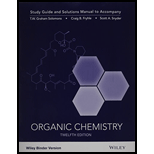
Concept explainers
Consider a chemical species (either a molecule or an ion) in which a carbon atom forms three single bonds to three hydrogen at-oms and in which the carbon atom possesses no other valence electrons. (a) What formal charge would the carbon atom have? (b) What total charge would the species have? (c) What shape would you expect this species to have? (d) What would you expect the hybridization state of the carbon atom to be?
Want to see the full answer?
Check out a sample textbook solution
Chapter 1 Solutions
Organic Chemistry, 12e Binder Ready Version Study Guide / Student Solutions Manual
Additional Science Textbook Solutions
Inorganic Chemistry
The Organic Chem Lab Survival Manual: A Student's Guide to Techniques
Living By Chemistry: First Edition Textbook
Chemistry: Matter and Change
Chemistry: Structure and Properties (2nd Edition)
Introductory Chemistry (6th Edition)
- Carbon dioxide, dinitrogen monoxide, the azide ion N3-, and cynate ion OCN- have the same arrangement of atoms and the ame number of valence shell electrons. Howeer, there are significant differences in the electronic structures. What hybridization should be assigned to the central atom in each species? Are there any resonance structures associated with these molecules and/or ions? If so, descrie them. Estimate the bond lengths and bond orders of each atom in these molecules and ions.arrow_forwardAssign hybridization state of each carbon, nitrogen, oxygen, halogen, and boron atom indicated with arrows in the molecules below.arrow_forwardFrom models of SF4, BrF3, and XeF4, deduce whether differentatom arrangements, called geometrical isomers, are possible, and,if so, sketch them below.Indicate the preferred geometry foreach case and suggest a reason for your choice.Indicatewhich structures have dipole moments, and show their direction. Molecule Dipole Moment Preferred Geometry SF4 BrF3 XeF4arrow_forward
- Draw three contributing structures of the following compound (called guanidine) and state the hybridization of the four highlighted atoms. In which orbitals do the three lone pairs drawn reside?arrow_forwardAspartame is a compound that is 200 times sweeter than sugar and is used extensively (under the trade name NutraSweet) in diet soft drinks. The skeleton structure of the atoms in aspartame is (a) Complete the Lewis structure and give the number of and bonds in aspartame. (b) What is the hybridization about each carbon atom that forms a double bond with an oxygen atom? (c) What is the hybridization about each nitrogen atom?arrow_forwardBoth the HCH and HCO bond angles of H2CO (formaldehyde) are very close to 120°, but oneis slightly smaller than the other. Predict which is smaller, and explain your reasoning.arrow_forward
- Calcium carbide (CaC2) is an intermediate in the manufacturing of acetylene (C2H2) . It is the calcium salt of the carbide (also called acetylide) ion (C22) . What is the electron configuration of this molecular ion? What is its bond order?arrow_forwardAll carbon-to-carbon bond lengths are identical in benzene. Does this argue for or against the presence of C=C bonds in benzene? Explain.arrow_forwardBenzene is commonly regarded as a resonance hybrid of the two Kekule structures, but other possible structures can also contribute. Draw three other structures in which there are only covalent π bonds (allowing for bonding between some non-adjacent C atoms) and two st ructu res in which there is one ionic bond. Why may these structures be ignored in simple descriptions of the molecule?arrow_forward
- Draw the line-bond structure formula of the following:arrow_forwardHow many hybrid orbitals are represented in the picture, hoe many s,p,d atomic orbitals corresponding to what hybridization, what electron pair, and what bond angle(s)?arrow_forwardWhich of the following molecules contains a nitrogen atom with linear geometry?arrow_forward
 Chemistry: The Molecular ScienceChemistryISBN:9781285199047Author:John W. Moore, Conrad L. StanitskiPublisher:Cengage Learning
Chemistry: The Molecular ScienceChemistryISBN:9781285199047Author:John W. Moore, Conrad L. StanitskiPublisher:Cengage Learning Principles of Modern ChemistryChemistryISBN:9781305079113Author:David W. Oxtoby, H. Pat Gillis, Laurie J. ButlerPublisher:Cengage Learning
Principles of Modern ChemistryChemistryISBN:9781305079113Author:David W. Oxtoby, H. Pat Gillis, Laurie J. ButlerPublisher:Cengage Learning Chemistry: Principles and PracticeChemistryISBN:9780534420123Author:Daniel L. Reger, Scott R. Goode, David W. Ball, Edward MercerPublisher:Cengage Learning
Chemistry: Principles and PracticeChemistryISBN:9780534420123Author:Daniel L. Reger, Scott R. Goode, David W. Ball, Edward MercerPublisher:Cengage Learning Organic Chemistry: A Guided InquiryChemistryISBN:9780618974122Author:Andrei StraumanisPublisher:Cengage Learning
Organic Chemistry: A Guided InquiryChemistryISBN:9780618974122Author:Andrei StraumanisPublisher:Cengage Learning Organic ChemistryChemistryISBN:9781305580350Author:William H. Brown, Brent L. Iverson, Eric Anslyn, Christopher S. FootePublisher:Cengage Learning
Organic ChemistryChemistryISBN:9781305580350Author:William H. Brown, Brent L. Iverson, Eric Anslyn, Christopher S. FootePublisher:Cengage Learning





